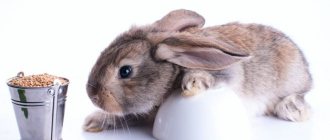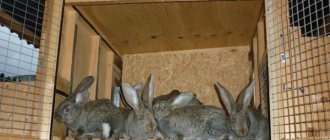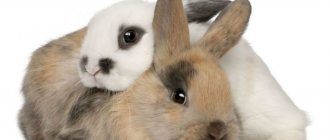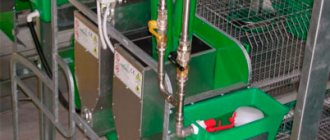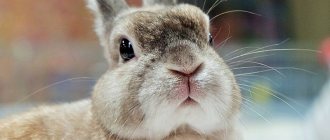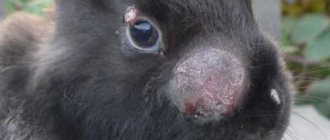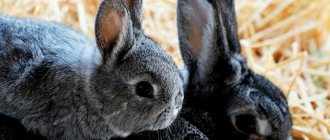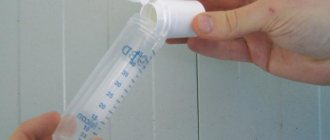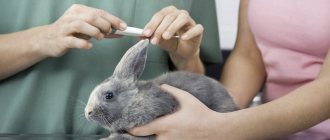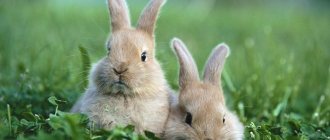The essence of the mini-farm I.N. Mikhailova
The design is designed in the form of a machine that provides automatic care for the animals. With a competent approach, the farm owner participates in the process to a minimum. At the same time, he regularly monitors the condition of the animals and the proper functioning of the mini-farm.
Igor Nikolaevich’s goal was to raise accelerated rabbits that were resistant to adverse environmental factors. He placed the animals in outdoor conditions, providing them with the necessary things: a place to live, food and water, and cleaning of the premises. Even his little rabbits live in spartan conditions and grow and develop well. The cages are provided with natural ventilation and a system for collecting pet feces. The new generation of accelerated rabbits has obvious advantages over other animals:
- high immunity;
- thick hair;
- heavy weight.
The large weight of pets is due to the natural environment in which they are kept. As in nature, they have to accumulate fat deposits in order to withstand bad weather and winter cold.
Important! Under “greenhouse” conditions, rabbits’ immunity declines, and the body’s ability to survive declines to the limit. By creating a Spartan mini-farm I.N. Mikhailov managed to awaken the defense mechanisms of animals. They are laid down at the genetic level.
Little rabbits stay near their mother for three months after birth. They receive her warmth and milk and learn to live independently. If the mother rabbit is fed well and not disturbed too much, the offspring will quickly gain weight. Three- and four-month-old young animals can weigh from 4 to 6 kg. The female breeds rabbits not just once a season, but all year round.
A mini-farm according to Mikhailov can be built on a large or small plot. There are rabbit breeding enterprises where this method has been successfully used for many years.
Features of the design of cages for rabbits using the Mikhailov method
Igor Mikhailov’s cage is a well-thought-out design, in each compartment of which the animal can be located either at the back warm wall or at the front, cooler and open to the sun’s rays.
The building has a well-designed ventilation system and maintains a comfortable temperature. An automatic food and water supply system is also installed. Taking into account the cold period, a heated drinking bowl is arranged. The cage is cleaned of animal waste automatically into a separate sealed container, which is cleaned periodically.
- Also among the advantages of the cage it is worth noting:
- good litters and active growth of rabbits;
- good health and immunity of animals;
- savings on purchasing new animals;
- saving time due to automation of the mini-farm;
- the ability to make a cage yourself.
The only disadvantages include the considerable costs of materials for making the cage, but taking into account all its advantages, these investments quickly pay off.
Features of cells
According to Mikhailov, cells are constantly ventilated. These are open sheds made of durable mesh. There are no side walls, but there is a plywood safety wall on the north side. The grid is on the south side. Thanks to this, there is always enough light and air in the cells. The sheds are isolated from one another by a network, and on top there is a lean-to roof with ventilation.
The farm is built on the principle of a multi-story house. 1.4 m2 is allocated for each animal. One cage can accommodate 25 rabbits. They live on the upper tier. Downstairs there is a room for eating. It has feeding troughs and drinking bowls. The floor is partly made of slatted mesh: this helps to dispose of feces.
There are 4 racks under the upper (living) tier. They provide structure fastening and strength. Between the posts there is a box for collecting litter. If you have experience, caring for eared animals will not take much time. On average, it will take 30 minutes.
This is interesting!
Why do you need a sloped ceiling? The slope corresponds to the shape of a rabbit hole in its natural habitat.
Design features
Based on scientific information, Mikhailov developed the optimal design of rabbit cages and rules for caring for animals, allowing them to increase their productivity, as well as reduce feed consumption and labor costs.
Details about the possibility of making Mikhailov’s “mini-farm” with your own hands (indicating the exact dimensions and a version of the drawing) are described in the article “Cages for rabbits” posted on our website.
The photo shows a rabbit “mini-farm” designed by Mikhailov
Let us only note the main features that distinguish this method from the two main breeding methods used by domestic livestock breeders on private farmsteads:
| Method of keeping | Specifics, advantages and disadvantages |
| "Traditional" cellular | The cellular method of maintenance requires a high investment of time and labor. It involves constant monitoring of the condition of animals and regular preventive measures. The owner selects optimal pairs for breeding, promptly separates the young animals from the queens, and divides the herd into repair and fattening parts. The disadvantages of this method are associated with the low physical activity of the animals, which leads to a decrease in natural immunity, as well as constant presence and feeding near waste products and a high risk of stress due to frequent contact with humans. Food and drinking water are supplied to animals in a manner that is far from their physiological needs, which leads to irrational consumption of feed and a decrease in animal productivity. In addition, many owners, trying to increase the number of litters per year, practice weaning young animals from lactating females too early, which negatively affects the health of the rabbits and their growth prospects |
| In pits (pit or pit) | This method is considered more economical in terms of equipment costs and less labor intensive. The living conditions of pets are close to natural. Animals have the opportunity to actively move and dig holes, which helps increase immunity and fertility. Among the disadvantages, it should be noted the inability to control the condition of rabbits, isolate sick animals, carry out regular vaccinations, as well as a “random” culling regime. The risk of death of the entire herd from infections is very high. In addition, uncontrolled mating occurs (including at an early age or with lactating females) and inbreeding. As a result, there are low indicators of health and survival of young animals, a decrease in herd productivity with each subsequent generation |
| "Mikhailovsky" | Professor Mikhailov’s acceleration method takes into account and eliminates all the disadvantages of the methods described above. Animals are kept in individual cages or in groups (rabbits of the same age). All activities related to protecting their health can be carried out regularly. Cages for young animals are designed according to the semi-walking type, which helps to increase the physical activity of young animals. The feeding process takes into account the physiological characteristics of the animals - they can eat fractionally (up to 80 “approaches” to food per day). This ensures successful growth with optimal feed costs. Rabbits are separated from females at the age of 90 days. Three months of breastfeeding improves immunity and creates additional conditions for rapid weight gain. Rabbit cages are equipped with heated nesting chambers, which are located slightly below floor level (as in the burrows of wild rabbits). Comfortable conditions help animals reproduce regardless of the time of year, and increase the number of newborn rabbits and their survival rate. The dwellings of the “eared animals” are equipped with systems for removing waste and forced ventilation, which improves the microclimate and reduces the risk of developing diseases. Each cage has a hopper feeder that can be refilled approximately once a week, as well as a large drinking bowl that is heated in winter. The “mini-farm” device allows you to protect rabbits from unnecessary contact with humans and the stress associated with such events. In addition, the work of constant care for wards does not require a lot of time and labor |
A well-equipped dwelling for rabbits, designed by Mikhailov, helps to maintain cleanliness and order both in places where animals are kept and in the surrounding area without any extra effort.
The one-time costs required to build a “Mikhailovsky” mini-farm are not that high (comparable to the costs of organizing a small shad with “traditional” cages). With proper use, it lasts for 10-15 years.
Selection of building materials and tools
You can build cells according to Mikhailov using simple tools:
- screwdriver;
- ax;
- a set of self-tapping screws;
- hacksaws;
- hammer;
- nails;
- building level.
You need to stock up on materials;
- two sheets of durable plywood;
- nails;
- 4 bars and 4 boards;
- roofing felt (8m2);
- nails;
- paint;
- galvanized iron sheet for roofing;
- rigid fiberboard sheet (2m);
- soft fiberboard sheet;
- picket fence
Detailed analysis
At the top of the truss roof there is a pipe for ventilation. The roof itself is built at a downward slope. The departments where rabbits are kept include a walking room and a queen cell. The queen cell is equipped with an electrical outlet. When the baby rabbits appear, it needs to be warmed up for the first time. There are also containers for water and food. Nearby there is a metal slope along which waste flows. They accumulate in the bottom box.
Walking and nesting compartments
The lower part of the cage is placed on the stand. The frame consists of 4 racks. The cross-section of each of them is 20x100 mm. On the eastern side, the walking and nesting area is protected by a net. You need to cut a hole in it. It will divide the three-story house into several sections. Animals can hide in them if they feel uncomfortable. One room serves as a trap. It is used if the rabbit needs to be moved to another cage or provided with medical assistance.
Walking room
Rabbits eat food and drink water in it. I.N. Mikhailov advises using bunker types of feeders and a canister-shaped drinker. At the bottom of the walking section there is a hole (200X200 mm) that goes into the shaft. The slatted floor has a cross-section of 20x45 mm. The picket fence is laid on a frame made of slats so that the window for manure and the feeder remain on top. The angle of the flooring must be at least 45 degrees. Thanks to this solution, the little ear will not get injured when jumping.
Important!
Rabbits love to sharpen their teeth. Wooden slats must be protected by covering them with metal.
Rabbit nesting compartment
A folding door is installed in the nesting sector. This is convenient if you need to help a mother rabbit with her babies. The floor should be solid, 9 cm below the bottom. Heat will not escape from the room, and the babies will not crawl far from their mother. The mother liquor is insulated both inside and outside.
A little about the author of the method
Igor Nikolaevich Mikhailov (1926-2004) – scientist, inventor, athlete, actor and writer. During the Great Patriotic War, he took part in the defense of Leningrad and served in aviation.
Professor I. N. Mikhailov is a “recognized legend” of rabbit breeding, founder and scientific director of the MIACRO department, multiple laureate of the Russian Farmer world fair.
After the war, he graduated from the Institute of Cinematography, was an actor in the drama theater, and played about 150 roles in films. At the same time, he was engaged in skeet shooting, won several sports awards, and conducted coaching work. Later, while teaching at the Leningrad Institute of Physical Education, he delved into the study of physiology. In the 70s of the last century, he became interested in breeding rabbits and, as an amateur breeder, observing his charges, he developed his own “acceleration” method. He became the author of five books, the owner of three patents for inventions, as well as awards from many domestic and foreign agricultural exhibitions.
Automatic drinking device
It is attached to the wall of the walking compartment. The drinking bowl is arranged automatically. It looks like a bowl. Several 5 liter canisters are inverted into a bowl. A hole of 1x1 cm is made in the stopper of the canister. The liquid enters the container in small portions. The drinker works on a vacuum principle: water enters the bowls under pressure. In winter, the bowl is half hidden from animals, and a boiler is placed in the fenced part. The finished unit will work automatically if the air temperature is below +8C. When the temperature rises to 12C, it will automatically turn off.
Advice from professionals
Rabbit breeding according to Mikhailov has been known for about 40 years. During this time, the professor gained followers who advise beginners the following:
- Place the cage so that it does not fall from strong winds. The best way is to place several mini-farms in a row, uniting them with a common roof. Place the houses on a solid support: concrete, asphalt.
- Do not immediately invest large amounts of money in creating a farm. Start with a few cells and test your strength.
- Do some selection. Select fertile females that quickly gain weight in males and use them and their offspring for further breeding. Reject weak, defective, sick animals.
- Make sure that the rabbits are not disturbed by the sun in the summer (install a canopy) and frost in the winter (insulate the cages in the fall).
- Hygiene is the key to success. Disinfect feeders, drinking bowls, house floors, change the bedding every 1-1.5 weeks. Keep newly purchased animals in quarantine for a month.
- New food is introduced to rabbits gradually, in small portions.
- Keep an eye on the droppings: liquid feces mean that one of the animals is sick.
- Don’t skimp on cages: there should be no more than 20-25 rabbits in one cage at a time (including babies).
The Mikhailov method is an effective way to make money for people who understand rabbits. With small expenses on feed, the purchase of accelerated rabbits, and the construction of mini-farms, within six months you will receive a large income from the sale of valuable rabbit meat, skins and other products. And if you are still unsure, there are reviews and video tutorials on this topic on the Internet.
Rabbit nutrition
Rabbit breeders feed the animals three or twice a day. In the wild, animals eat 40-80 times a day. Feeding them three times a day may not be enough. Rabbits living in cages using the Mikhailov method can eat whenever they want. Access to food is available at any time.
Compound feeder for simple feed
The feeder should be located close to the drinking bowl. This is a device with a pull-out shelf. It is located in the hole between the flooring. Crumbs from food settle on the shelf. You need to surround the container with a small threshold: this way the rabbits will not turn it over.
From the outside, the feeder resembles a mailbox with a folding top. The food can be topped up at any time. A sieve is also provided. Through it, scraps fall into a container for disposal. Clean feed is served to a distribution window with a diameter of 100x100 mm.
Advice!
The disposal should always be kept clean to prevent the growth of harmful bacteria.
Container for roughage
There should be two containers for roughage: on the lower and upper floors. The feeder is made in the form of a folding hopper. Branches and hay are placed in it. When the top cover is made heavier, the food is always close to the net, freely accessible to the animals.
Scientific basis of the “Mikhailovsky” method
When creating his method, Professor Mikhailov proceeded from the fact that the conditions of detention should maximally correspond to the physiological and behavioral characteristics that the animals inherited from their wild ancestors. The breeding method proposed by the scientist was based on the following scientific data.
Wild rabbits, from which all modern breeds and varieties originate, in nature never defecate in the places where they feed and rest . “Domesticated” animals, when kept in pits or ordinary cages, not only eat food that comes into close contact with waste, but also breathe air saturated with harmful fumes, which, of course, does not promote health.
Animals require constant access to clean drinking water.
For normal life, rabbits need a large amount of clean water , but in captivity it is not so easy to ensure its availability: the owner is forced to frequently fill drinking bowls, which become very dirty and even freeze in cold weather.
Read about the most common water supply systems and how to make them yourself in the article “Drinkers for rabbits”
The digestion of rabbits has an interesting feature : the muscles that force food to move from the stomach to the intestines during the digestion process do not contract actively enough in these animals. That is why the “eared animals” are forced to constantly chew and gnaw something, “forcibly” pushing the food bolus through the gastrointestinal tract. For complete absorption of feed and effective growth, animals must eat “fractionally”; traditional feeding schemes (two to three times a day) are not entirely suitable for them.
In nature, female rabbits arrange nesting chambers in the most secluded corners of their burrows - quiet, calm and most protected from dampness, drafts and temperature changes. Babies spend the first weeks of life in peace, darkness and warmth. With “traditional” keeping of animals, such conditions are not always provided, which has a bad effect on the quantity and quality of offspring.
You will find step-by-step instructions for constructing a queen cell for a female rabbit in a separate article on our website.
Females prepare nests in advance for giving birth in secluded places and feed the emerging cubs with their milk for quite a long time.
At the age of 4-5 weeks, rabbits of most breeds can already eat “adult” food, but this does not mean that they stop needing mother’s milk. Long-term (about 3 months) milk feeding not only maximally strengthens the natural immunity of young animals, but also makes babies “accelerators”. They begin to more fully absorb the nutrients they receive from food and gain weight faster. Late weaning improves the taste of meat and the quality of skins, and also increases the fertility of subsequent generations.
Human contact is a stressful factor for rabbits . Daily cleaning of cages, filling drinking bowls and feeders has a bad effect on the well-being of animals, their appetite and readiness to reproduce.
Upper tier device
The top tier can be made the same as the bottom, but with a difference in length (25 cm). The tier is intended for planting young animals and consists of two sections. On the right there is a small balcony. In the second option there is no double bottom. The rigidity of the building is increased with the help of slats. The cross section of the slats is 20x80 mm. They are placed perpendicularly. The mesh on the south side has doors and feeders.
Advantages of the Mikhailov method
In fact, this is a machine that independently cares for animals.
Human participation in the process is minimal . The conditions are truly Spartan: all year round, rabbits (and even babies!) live outside in constantly ventilated cages. And a special design at the bottom itself collects and removes waste. That is, the animals do not have to breathe ammonia and other toxic substances. It turns out a completely new generation of eared ones. As a rule, they are called "accelerators", hence the common name " accelerated rabbit breeding ". They are completely different from their relatives - the Old Believers. They have excellent immunity, stamina, thicker fur and record weight. Since, willy-nilly, they will have to accumulate fat for the winter.
Mikhailov relied on the genetic defense mechanism of the rabbit, which atrophies from a “rich” life. By the way, nature has built something similar into humans! Not all of us, the darlings of civilization, are able to survive in the wild.
Rabbits adapt to everything faster. According to the Mikhailov method, babies do not leave their mother for the first three months. They feed on its milk, bask in its warmth and prepare for independence. During this time, they already gain weight up to 4-6 kilograms.
The absence of people and additional disturbance on their part ensures not seasonal, but year-round offspring.
Mikhailov’s method and his mini farm for rabbits are included in all textbooks of agricultural universities and colleges.
It is also popular among professional rabbit breeders. Now it is successfully used not only in small enterprises, but in large peasant farms and collective farms. So what is the secret of Mikhailov’s mini-farm?
Features of self-production
Each master can improve the design at his own discretion. There is no clear plan for making a rabbit farm. Now farmers use different versions of I.N. cells. Mikhailova. You should focus on the number of animals, the interchangeability of materials and their quality:
- prepare the correct drawing;
- think over the technology of product strength;
- select materials;
- prepare tools;
- At the end of the work, check the strength of the doors, compartments, and the proper operation of all devices.
Classifications of cages for rabbits
Houses for eared pets are classified according to a number of parameters. The first is size and height. Main cell options:
- in two tiers;
- in three tiers;
- simple;
- multi-tiered.
Depending on what rabbits the home is intended for, cages are available for:
- females;
- young animals;
- decorative animals;
- dwarf breeds and giants, etc.
Read how to care for a decorative rabbit here.
Cages for rabbits are distinguished by tiers, breed and age.
The most popular materials are metal, metal profile, mesh, wood. Less common, but other options can be used. There are summer and winter models, for installation in an apartment or outdoors, monolithic and portable. We recommend that you familiarize yourself with the features of caring for the Burgundy rabbit in this material.
Houses for rabbits can be fattening houses. Industrial cages are included in a separate group, but you can’t make them yourself.
Price
The price of a farm depends on the size of the room, its arrangement and the quality of materials. A small wooden cage can be made for 2,500 rubles (without equipment). If the design contains elements made of plastic or metal, the cost will be more – from 4,500 rubles. A lot of money will be spent on the purchase and installation of automatic equipment. A feeder for soft food will cost about 1,500 rubles, a hay box costs 1,000 rubles, a feeding box costs 1,200 rubles, an automatic drinker costs 2,300 rubles, and a temperature sensor costs about 2,000 rubles.
In order to make a reliable and practical housing for rabbits, the farmer will have to invest a lot of money in it. It is also necessary to take into account the price of the farm’s inhabitants: one breeding male costs approximately 2500-3000 rubles. It will be possible to recoup all costs in a year and a half.
Reviews
Sergey (Gomel):
“I made cells using Mikhailov’s method. Maintenance turned out to be not as simple as they say in books on rabbit breeding. The water in the drinking bowls quickly becomes dirty, so I installed a nipple automatic drinking bowl in the house. Now the water is much cleaner. It remains to improve the feeders a little.”
Vitaly (Ryazan region):
“I really like Mikhailov’s cages. They help save time. I don't always have the opportunity to regularly clean up after the rabbits and feed them. If I need to leave for a few days, I leave food in the feeders and water in the drinkers. Rabbits are well fed and drink enough fluids. When I return, I clean the waste tank. Simple and convenient.”
Building cells using the Mikhailov method is not an easy task. It requires financial investment and ingenuity. If you put in the effort and think things through, you can get an excellent rabbit farm that will definitely pay off in the next year and a half.
About the breeding method
Academician I.N. Mikhailov has developed a fundamentally new breeding method, which is based on the maximum use of the biological resources and potential of the rabbit, genetically endowed abilities for rapid growth and natural development in the first months after its birth.
Located in a village and stay all year round
In addition, the need for regular cell cleaning is almost completely eliminated - in the design developed by I.N. Mikhailov successfully uses automatic removal of natural waste products. Such a farm operates in a semi-automatic mode and spends approximately thirty minutes a week of your time on its full maintenance.
Video on getting to know Mikhailov farms:
The academician refutes the outdated and imperfect methods on the basis of which rabbits were kept using predominantly an external cage system, and the result was not year-round, but only seasonal reproduction of the rabbit, along with this there was a fairly high morbidity and mortality of young animals.
One of the structural features of the stomach is muscle weakness, since the stomach muscles do not have the ability to quickly contract and move digested food directly into the intestines.
It is for this reason that the rabbit is forced to constantly chew something. Adults eat up to eighty times a day. With typical 2 or 3 meals a day, it is impossible to satisfy the natural needs of rodents.
Pets feel comfortable
Thanks to the unique design of the vacuum drinker, the development of harmful microorganisms in the water is not possible. Due to a complete and uninterrupted diet, rabbits begin to consume food four times less than usual.
Thanks to the design of the farm, natural waste falls into a special tray, which is cleaned once a week. The farm is equipped with a special forced ventilation system, as a result of which there is no unpleasant odor in the nests that attracts insects. Accelerator rabbits breathe not polluted, but clean and fresh air.
The operation of the farm supports electrical heating of the queen cells. The use of this innovation has a double benefit: the energy value of consumed feed in winter is directed not towards heating the body, but towards enhanced growth and acceleration. The use of electric heating makes it possible to obtain stable births all year round, regardless of weather conditions.
